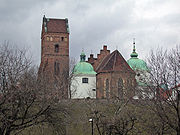
St. Mary's Church, Warsaw
Encyclopedia


Warsaw
Warsaw is the capital and largest city of Poland. It is located on the Vistula River, roughly from the Baltic Sea and from the Carpathian Mountains. Its population in 2010 was estimated at 1,716,855 residents with a greater metropolitan area of 2,631,902 residents, making Warsaw the 10th most...
, Poland
Poland
Poland , officially the Republic of Poland , is a country in Central Europe bordered by Germany to the west; the Czech Republic and Slovakia to the south; Ukraine, Belarus and Lithuania to the east; and the Baltic Sea and Kaliningrad Oblast, a Russian exclave, to the north...
. It is one of oldest buildings and one of the few surviving examples of Gothic architecture
Gothic architecture
Gothic architecture is a style of architecture that flourished during the high and late medieval period. It evolved from Romanesque architecture and was succeeded by Renaissance architecture....
in the city. It is located at ulica Przyrynek 2.
History
St. Mary's Church stands on the site of an ancient paganPaganism
Paganism is a blanket term, typically used to refer to non-Abrahamic, indigenous polytheistic religious traditions....
place of worship
Place of worship
A place of worship or house of worship is an establishment or her location where a group of people comes to perform acts of religious study, honor, or devotion. The form and function of religious architecture has evolved over thousands of years for both changing beliefs and architectural style...
. The church's foundation stone was laid by Janusz I the Old, Duke of Masovia and his wife, Danutė of Lithuania
Danute of Lithuania
Danutė of Lithuania was a Lithuanian princess, daughter of Kęstutis, Grand Duke of Lithuania. She was married to Janusz I of Warsaw, one of the dukes of Masovia. Very little reliable information is known about her life.The date of her marriage is confused in many sources...
, in 1410. The church was consecrated
Consecration
Consecration is the solemn dedication to a special purpose or service, usually religious. The word "consecration" literally means "to associate with the sacred". Persons, places, or things can be consecrated, and the term is used in various ways by different groups...
in 1411. It has been modified, demolished and rebuilt several times. Originally it had one nave, was made of brick
Brick
A brick is a block of ceramic material used in masonry construction, usually laid using various kinds of mortar. It has been regarded as one of the longest lasting and strongest building materials used throughout history.-History:...
s, had a ceiling and an arch presbytery, before the end of the 15th century it was transformed into a three nave
Nave
In Romanesque and Gothic Christian abbey, cathedral basilica and church architecture, the nave is the central approach to the high altar, the main body of the church. "Nave" was probably suggested by the keel shape of its vaulting...
basilica
Basilica
The Latin word basilica , was originally used to describe a Roman public building, usually located in the forum of a Roman town. Public basilicas began to appear in Hellenistic cities in the 2nd century BC.The term was also applied to buildings used for religious purposes...
.
The church's most striking characteristic is the tower, built in 1518. It is recognizable from a great distance and is depicted in the oldest images of Warsaw
Warsaw
Warsaw is the capital and largest city of Poland. It is located on the Vistula River, roughly from the Baltic Sea and from the Carpathian Mountains. Its population in 2010 was estimated at 1,716,855 residents with a greater metropolitan area of 2,631,902 residents, making Warsaw the 10th most...
.
During World War II
World War II
World War II, or the Second World War , was a global conflict lasting from 1939 to 1945, involving most of the world's nations—including all of the great powers—eventually forming two opposing military alliances: the Allies and the Axis...
, the church was severely
Planned destruction of Warsaw
The planned destruction of Warsaw refers to the largely realised plans by Nazi Germany to completely raze the city. The plan was put into full motion after the Warsaw Uprising in 1944...
damaged by German forces - the roof of the nave collapsed and the upper portion of the tower was blown up. It was reconstructed in 1947-1966 to the design by Beata Trylińska.
Behind the church is small park with a set of steps that lead down to the Vistula and the so named Kościuszko
Tadeusz Kosciuszko
Andrzej Tadeusz Bonawentura Kościuszko was a Polish–Lithuanian and American general and military leader during the Kościuszko Uprising. He is a national hero of Poland, Lithuania, the United States and Belarus...
banks of the river. In the square there are outdoor theatre performances and concerts which are organized locally.
See also
- St. Kazimierz Church
- St. Hyacinth's ChurchSt. Hyacinth's Church, Warsaw-History:St. Hyacinth's Church was founded by the Dominican Order and adjoins Warsaw's largest monastery. The church is a mixture of Renaissance and early-Baroque styles. Its construction began in 1603 and was completed in 1639....
- St. John's CathedralSt. John's Cathedral, WarsawSt. John's Archcathedral in Warsaw is a Catholic church in Warsaw's Old Town, is the only one archcathedral in Warszawa, the other 3 are cathedrals in the Polish capital. St. John's stands immediately adjacent to Warsaw's Jesuit church, and is one of the oldest churches in the city and the main...
- St. Martin's ChurchSt Martin's Church, WarsawSt. Martin's Church is a church in Warsaw, Poland. It is located on ulica Piwna in the Polish capital's Old Town.-History:...

